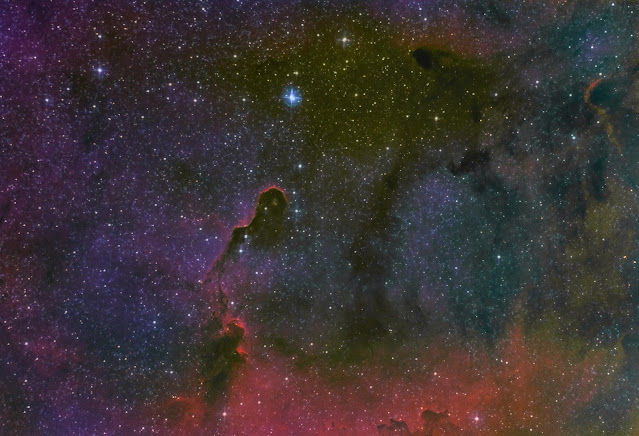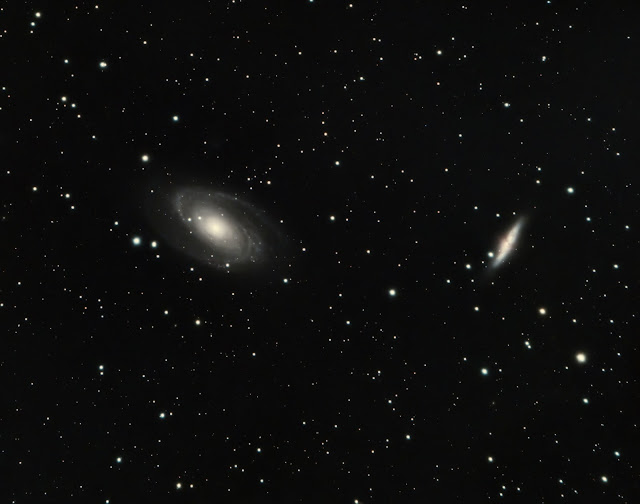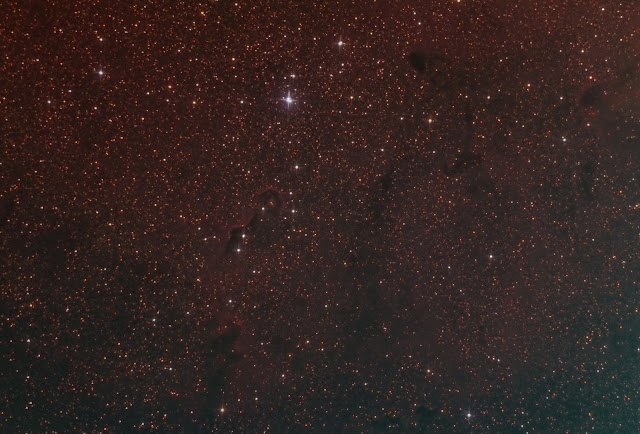More about lessons learned and planning but also to share my astrophotography
Thursday, June 24, 2021
Bubble Nebula and M52 in SHO palette... two ways
Monday, June 21, 2021
Wild Duck Cluster (M11)
Wild Duck Cluster (M11)
Captured the Wild Duck cluster after our Public Star Party and Peck Farm Park,
CAPTURE INFO
Bandwidths:
R, G, B, L
Date Captured:
June 6 & June 10, 2021, Batavia, IL (Bortle 7/8)
GUIDING NOTES:
Good, averaging ~0.7 RMS
IMAGE CALIBRATION (PixInsight)
Weighted Batch Preprocessing
- Lights, Darks, Flat Darks, Bias
- Cosmetic Correction
- Stats
- L (30) 15 second subs
- R (20) 60 second subs
- G (20) 60 second subs
- B (20) 60 second subs
Normalize Scale Gradient > Star Alignment of each channel
NON LINEAR PROCESSING (PixInsight)
1. Dynamic Crop of each channel
2. Automatic Background Extraction
3. Linear Noise Reduction to each channel using MultiscaleLinearTransform
4. Another Linear Noise Reduction using MultiscaleLinearTransform
5. Linear fit RGB to L
LINEAR PROCESSING (PixInsight)
1. Easy Soft Stretch script on each channel
2. RGB Combine
2. SCNR
4. Blurred RGB stars using Convolution
3. Starnet++ to remove the stars and create a image of the stars
4. (Starless Image) Used Curves to reduce the background skyglow/light pollution.
10. (Stars Image) Decreased star brightness by 10%
11. (Stars Image) Increased saturation of the stars using ColorSaturation
12. Added stars to the background using PixelMath
13. Made image ready for the web using ICCProfileTransformation
EQUIPMENT
Optics: SGO 6" f/4 Imaging Newtonian @ 610mm FL
Baader 2" Coma Corrector
Camera: ZWO 294mm Pro (mono)
Filter Wheel: ZWO 8 position, .36" filters
Filters:
- L (Baader Planetarium LRGB 36 mm Round CCD Filter )
- R (Baader Planetarium LRGB 36 mm Round CCD Filter )
- G (Baader Planetarium LRGB 36 mm Round CCD Filter )
- B (Baader Planetarium LRGB 36 mm Round CCD Filter )
Mount:
- Losmandy GM811
- RAEXT EXTENSION DOVETAIL
- Losmandy 12" Tripod Extension
- Losmandy SADDLE PLATE FOR G-11 MOUNT
- Losmandy 16" UNIVERSAL DOVETAIL PLATE
- Losmandy LW Tripod
- Alt-AZ/Elevation Tensioning bolts and washers (Michael Herman's)
Guiding:
- ZWO 120mm mini (red filter)
- Agena 60mm f/4 (240mm FL) Guide Scope with Helical Focuser
- PHD2 Software (2.6.9 Dev 5)
- Multistar option
- RA algorithm: Predictive PEC
- Dec algorithm: Resist Switch
- Used previous calibration
- Dither: Small, every 3 frames
Acquisition:
- ASI Air Pro
Tuesday, June 15, 2021
Starting up the Bubble Nebula with M52 (RGB)
Starting up the Bubble Nebula with M52 (RGB)
Why this target?
I was going to head to some more obscure objects but I wanted to capture the Nova in Casseiopia, V1405 Cassiopeiae. It really is amazingly bright compared to last year.
About the Targets
https://apod.nasa.gov/apod/ap110914.html
Embedded in a complex of interstellar dust and gas and blown by the winds from a single, massive O-type star, the Bubble Nebula, also known as NGC 7635, is a mere 10 light-years wide. On the other hand, M52 is a rich open cluster of around a thousand stars. The cluster is about 25 light-years across. Seen toward the northern boundary of Cassiopeia, distance estimates for the Bubble Nebula and associated cloud complex are around 11,000 light-years, while star cluster M52 lies nearly 5,000 light-years away. The wide telescopic field of view spans about 1.5 degrees on the sky or three times the apparent size of the Full Moon.
CAPTURE INFO
Bandwidths:
R, G, B, L
Date Captured:
June 6 & June 10, 2021, Batavia, IL (Bortle 7/8)
GUIDING NOTES:
Good, averaging ~0.7 RMS
IMAGE CALIBRATION (PixInsight)
Weighted Batch Preprocessing
- Lights, Darks, Flat Darks, Bias
- Cosmetic Correction
- Drizzle Generation
- Stats
- R (20) 60 second subs
- G (20) 60 second subs
- B (20) 60 second subs
- Drizzle Integration @ 2x
NON LINEAR PROCESSING (PixInsight)
1. Dynamic Crop
2. Automatic Background Extraction
3. Dynamic Background Extraction
4. Linear Noise Reduction to each channel using MultiscaleLinearTransform
5. Another Linear Noise Reduction using MultiscaleLinearTransform
7. Channels were combined with ChannelCombination
LINEAR PROCESSING (PixInsight)
1. Easy Soft Stretch script
2. SCNR on the G channel
3. Starnet++ to remove the stars and create a image of the stars
4. (Starless Image) Used HistogramTransformation to reduce the background skyglow/light pollution.
5. (Starless Image) TGV Denoise to remove more noise
6. (Starless Image) Ran HDRMultiscaleLinearTransform to smooth background
7. (Starless Image) Ran a slight "S" curve using CurvesTransformation
8. (Starless Image) Ran MultiscaleLinearTransform to sharpen
9. (Starless Image) Ran LocalHistogramEqualization 2 times 25/75 Kernel Radius for Contrast
10. (Stars Image) Decreased star brightness by 10%
11. (Stars Image) Increased saturation of the stars using ColorSaturation
12. Added stars to the background using PixelMath
13. Made image ready for the web using ICCProfileTransformation
EQUIPMENT
Optics: SGO 6" f/4 Imaging Newtonian @ 610mm FL
Baader 2" Coma Corrector
Camera: ZWO 294mm Pro (mono)
Filter Wheel: ZWO 8 position, .36" filters
Filters:
- R (Baader Planetarium LRGB 36 mm Round CCD Filter )
- G (Baader Planetarium LRGB 36 mm Round CCD Filter )
- B (Baader Planetarium LRGB 36 mm Round CCD Filter )
Mount:
- Losmandy GM811
- RAEXT EXTENSION DOVETAIL
- Losmandy 12" Tripod Extension
- Losmandy SADDLE PLATE FOR G-11 MOUNT
- Losmandy 16" UNIVERSAL DOVETAIL PLATE
- Losmandy LW Tripod
- Alt-AZ/Elevation Tensioning bolts and washers (Michael Herman's)
Guiding:
- ZWO 120mm mini (red filter)
- Agena 60mm f/4 (240mm FL) Guide Scope with Helical Focuser
- PHD2 Software (2.6.9 Dev 5)
- Multistar option
- RA algorithm: Predictive PEC
- Dec algorithm: Resist Switch
- Used previous calibration
- Dither: Small, every 3 frames
Acquisition:
- Mini PC Beelink T4 @ scope
- MS Windows Remote Desktop to mini PC
- Sequence Generator Pro 3.2.660
Monday, June 14, 2021
Globular Cluster M10
Globular Cluster Messier 10
Friday, June 11, 2021
Open Cluster NGC 7160
Open Cluster NGC 7160
 |
| NGC 7160 Annotated View |
 |
| NGC 7160 (RGB Stars Only) |
About NGC 7160
"NGC 7160 is an open cluster in the constellation Cepheus. It was discovered by William Herschel on November 9, 1789. The cluster was also observed by John Herschel on October 7, 1829."
- Constellation: Cepheus
- RA: 21h 53m 40s
- Dec: +62° 36′ 12″
- Distance: 2,570 ly
- Magnitude: ~6.1
- Width: 13'
Capturing NGC 7160
-------------------
Light Bandwidths:
R, G, B
Dates Captured:
June 5, 2021
June 9, 2021
June 10, 2021
GUIDING
- excellent, average ~0.7 RMS
IMAGE CALIBRATION (PixInsight)
Weighted Batch Preprocessing
- Lights, Darks, Flat Darks, Bias
- Cosmetic Correction
- Stats
- R (31) 60 second subs
- G (20) 60 second subs
- B (30) 60 second subs
NON LINEAR PROCESSING (PixInsight)
1. Dynamic Crop
2. Dynamic Background Extraction
3. Linear Fit was applied to G & B using R as base.
4. Channels were combined with ChannelCombination
4. Photometric Color Calibration failed to download so used: AutoColor script
5. Linear Noise Reduction using MultiscaleLinearTransform
6. Another Linear Noise Reduction using MultiscaleLinearTransform
LINEAR PROCESSING (PixInsight)
1. Histogram Stretch
2. Automatic Backgtound Extraction
3. Starnet++ to remove the stars and create a image of the stars
4. SCNR
5. (Starless Image) Used Curves to reduce the background skyglow/light pollution.
6. (Starless Image) TGV Denoise to remove more noise
7. (Stars Image) Increased saturation of the stars using ColorSaturation
8. Made image ready for the web using ICCProfileTransformation
EQUIPMENT
Optics: SGO 6" f/4 Imaging Newtonian @ 610mm FL
Baader 2" Coma Corrector
Camera: ZWO 294mm Pro (mono)
Filter Wheel: ZWO 8 position, .36" filters
Filters:
- R (Baader Planetarium LRGB 36 mm Round CCD Filter )
- G (Baader Planetarium LRGB 36 mm Round CCD Filter )
- B (Baader Planetarium LRGB 36 mm Round CCD Filter )
Mount:
- Losmandy GM811
- RAEXT EXTENSION DOVETAIL
- Losmandy 12" Tripod Extension
- Losmandy SADDLE PLATE FOR G-11 MOUNT
- Losmandy 16" UNIVERSAL DOVETAIL PLATE
- Losmandy LW Tripod
- Alt-AZ/Elevation Tensioning bolts and washers (Michael Herman's)
Guiding:
- ZWO 120mm mini (red filter)
- Agena 60mm f/4 Guide Scope with Helical Focuser
- PHD2 Software (2.6.9 Dev 5)
- Multistar option
- RA algorithm: Predictive PEC
- Dec algorithm: Resist Switch
- Used previous calibration done
- Dither: Small, every 3 frames
Acquisition:
- Sequence Generator Pro 3.2.660
- Flats & FlatDarks using NINA Flat Wizard
Light Bandwidths:
R, G, B
Dates Captured:
June 5, 2021
June 9, 2021
June 10, 2021
GUIDING
- excellent, average ~0.7 RMS
IMAGE CALIBRATION (PixInsight)
Weighted Batch Preprocessing
- Lights, Darks, Flat Darks, Bias
- Cosmetic Correction
- Stats
- R (31) 60 second subs
- G (20) 60 second subs
- B (30) 60 second subs
NON LINEAR PROCESSING (PixInsight)
1. Dynamic Crop
2. Dynamic Background Extraction
3. Linear Fit was applied to G & B using R as base.
4. Channels were combined with ChannelCombination
4. Photometric Color Calibration failed to download so used: AutoColor script
5. Linear Noise Reduction using MultiscaleLinearTransform
6. Another Linear Noise Reduction using MultiscaleLinearTransform
LINEAR PROCESSING (PixInsight)
1. Histogram Stretch
2. Automatic Backgtound Extraction
3. Starnet++ to remove the stars and create a image of the stars
4. SCNR
5. (Starless Image) Used Curves to reduce the background skyglow/light pollution.
6. (Starless Image) TGV Denoise to remove more noise
7. (Stars Image) Increased saturation of the stars using ColorSaturation
8. Made image ready for the web using ICCProfileTransformation
EQUIPMENT
Optics: SGO 6" f/4 Imaging Newtonian @ 610mm FL
Baader 2" Coma Corrector
Camera: ZWO 294mm Pro (mono)
Filter Wheel: ZWO 8 position, .36" filters
Filters:
- R (Baader Planetarium LRGB 36 mm Round CCD Filter )
- G (Baader Planetarium LRGB 36 mm Round CCD Filter )
- B (Baader Planetarium LRGB 36 mm Round CCD Filter )
Mount:
- Losmandy GM811
- RAEXT EXTENSION DOVETAIL
- Losmandy 12" Tripod Extension
- Losmandy SADDLE PLATE FOR G-11 MOUNT
- Losmandy 16" UNIVERSAL DOVETAIL PLATE
- Losmandy LW Tripod
- Alt-AZ/Elevation Tensioning bolts and washers (Michael Herman's)
Guiding:
- ZWO 120mm mini (red filter)
- Agena 60mm f/4 Guide Scope with Helical Focuser
- PHD2 Software (2.6.9 Dev 5)
- Multistar option
- RA algorithm: Predictive PEC
- Dec algorithm: Resist Switch
- Flats & FlatDarks using NINA Flat Wizard
Thursday, June 10, 2021
Elephant's Trunk Nebula in the HaGO palette
Elephant's Trunk Nebula in the HaGO palette
So, this is the last of the Elephant's Trunk Nebula... in the HaGO palette.
Ha into the Red channel
Oiii into the Blue channel
Green into the Green channel (instead of Sii)
Stars are standard RGB
Now, I know this is art... even though it does represent those wavelengths of light. I really am enjoying this result!
 |
| Elephant's Trunk Nebula in the HaGO palette |
Here are the starless individual channels in order: Ha, G, Oiii along with the RGB stars
 |
| G |
 |
| Oiii |
 |
| RGB Stars |
Monday, June 7, 2021
Adding Ha to RGB Elephant's Trunk Nebula
Saturday, June 5, 2021
Elephant's Trunk Nebula in RGB
Friday, June 4, 2021
Preview of my first HSO palette with the Elephant's Trunk
Preview of my first HSO palette with the Elephant's Trunk
Tuesday, June 1, 2021
Elephant's Trunk Nebula in HOO
Elephant's Trunk in HOO
HOO == Hydrogen Alpha to Red Channel; Oiii to Green Channel; Oiii to Blue Channel.
Equipment:
Capture Device: Beelink Mini PC using Microsoft RDP to control
Optics: SGO 6" f/4 Imaging Newtonian @ 610mm FL
Baader 2" HR Coma Corrector
Camera: ZWO ASI294mm Pro
Filters: ( ZWO 7nm Ha & ZWO 7nm Oiii)
Mount: Losmandy GM811
Guiding: ZWO 120mm + PHD2 Software
Acquisition: Sequence Generator Pro
Exposures:
- Ha (Gain 200/Offset 21) - 18 exposures @ 180 Seconds (54 Minutes)
- Oiii (Gain 200/Offset 21) - 60 exposures @ 180 Seconds (3 Hours)
Calibration: 50 Bias, 30 Darks, 50 Flats per filter
Processing: PixInsight
Notes:
- (18) of (41) 180s Ha exposures (Thin clouds washed out the other 23)
- Best guiding I've ever had after tightening up my Dec axis. .55 Total RMS... even with dithering.
- Seeing = Average
- Transparency = Average
Galactic Ha Experiment with Bodes and Cigar Galaxies with a One Shot Color camera
I thought it might be a worthy experiment to see how the L-Ultimate filter could add to the Ha detail of galaxies using a OSC Camera. So th...

-
Introduction So, I thought I'd do a test to see results with the ZWO 533MC Pro camera using different gains on the same object. The goal...
-
Sh2-131 This was night 5 of a run of clear nights. VERY unusual in Illinois to say the least. Very happy that I can automate the capturing. ...





















